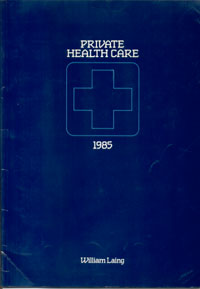Sign up to our newsletter Subscribe
Analysing Global Immunisation Expenditure

This survey covers all major areas of health care in Britain and describes the activity of the private and voluntary sectors in each. The organisation of chapters aims to follow coherent market boundaries. In many cases, these coincide roughly with NHS administrative divisions.…
This survey covers all major areas of health care in Britain and describes the activity of the private and voluntary sectors in each. The organisation of chapters aims to follow coherent market boundaries. In many cases, these coincide roughly with NHS administrative divisions. The congruence breaks down, however, in the case of long term nursing and residential care of elderly people. Here, the reality of a single market is acknowledged, despite the statutory distinction between ‘nursing’ and ‘personal’ care, and between facilities provided and regulated by health and local authorities.
The total value of services supplied by the independent sector, in each of the major markets, is set out in Table 1.1. Overall, independent hospital based services (excluding local authority registered residential care of the elderly) amounted to £827 million in the UK in 1984, or 7 per cent of the total cost of NHS and independent sector hospital based services combined. Employment provides an alternative measure of relative size, giving much the same result. In December 1983 an estimated 25,700 whole-time-equivalent
(WTE] nurses were employed in independent hospitals and nursing homes in England, accounting for 7 per cent of all WTE nursing staff employed in the NHS hospital service and the independent sector combined.
The survey attempts, wherever possible, to take the analysis one stage further by partitioning services into the four possible combinations of private1 and public finance and supply. In doing so it systematically uses the format illustrated in Figure 1.1. Analysis into these four component parts is crucially important in understanding the private/public mix in health care and avoiding confusion in the debate on ‘privatisation’.
To do this, it is necessary to look at individual elements of health care. Since, however, markets do not fit neatly within NHS boundaries, the choice of elements must be selective and a pragmatic approach must be adopted, sometimes using value as the basis of the four way partition and sometimes using volume of activity or level of facilities, according to the data that are available.
Services which are both publicly supplied and publicly financed cover the bulk of the NHS. Services which are publicly supplied but privately financed include, for example, NHS pay beds. They also include, in part, services for which NHS patients pay significant charges, such as prescription medicines. Privately supplied and publicly financed services include contractual bed arrangements and, much more important now, long term care financed by supplementary benefits. Finally, privately supplied and privately financed services include the bulk of treatment in independent hospitals.
Among the different markets there is wide variation in the public/private mix (Table 1.2). Most of the data relate to 1984. Where they do not, earlier years’ data remain valid at the date of publication, with the important exceptions of elective surgery and spectacle supply.
The data source for elective surgery is a major survey carried out in 1981 by the Medical Care Research Unit at the University of Sheffield. But the medically insured population expanded by 18 per cent between 1981 and 1984. Moreover, medical insurance expenditure on benefits has expanded by 40 per cent over the same period {after deflation by the retail price index). Thus the percentage of elective surgery undertaken privately in independent hospitals and NHS paybeds is now certainly substantially greater than the figure of 13 per cent in 1981.
In the case of spectacles, changes implemented in April 1985 limit NHS ophthalmic supply to certain categories of ‘poor’ clientele and it is envisaged that the NHS supply role will be completely phased out in time.
The extent of private involvement in health care, whether on the supply or demand side, is critically dependent upon four factors:
The limits that the NHS sets to its responsibilities.
For example, health authorities and health professionals accept the principle of shared responsibility with local authorities and their private sector counterparts for long term care of elderly, mentally ill and mentally handicapped people. Thus ‘free’ institutional care is available for only a minority of this clientele. ‘Alternative’ medicine, for its part, is seen as a fringe activity which except for some homeopathic medicine1 is not available under the NHS. Nor has the health service adopted a wholehearted commitment to providing abortions or to offering sterilisation as a means of birth control. In some cases a distinction is drawn between what is medically necessary and what is cosmetically desirable and the NHS has, for example, restricted itself to functional but unaesthetic spectacles and hearing aids.
The lack of any tradition in certain modes of health care delivery. Thus the NHS has not developed nursing homes on the private sector model, or along the lines adopted by some other countries’ health services. Nearly all its long term geriatric facilities still consist of hospital wards. Nor has the NHS any tradition in specialised hospice type care for terminally ill people. This has been pioneered instead by the voluntary sector which cares for significant numbers of NHS patients.
Medical insurance cover. For example, maternity is not covered by medical insurance and a very small proportion of women have their babies privately.
The marginal cost of care outside the NHS. In the hospital and community health services, as in general medical practice, the marginal cost of opting out of the NHS is equal to the full cost of private care, with no allowance made for any financial contribution to the NHS through taxation. It is this high marginal cost of private medical care which places a limit on its growth.
It is in those areas where the marginal cost of private treatment is relatively low, and where there is a significant supply constraint, that private sector demand and supply has flourished most, as in care of the elderly, abortion and sterilisation and the market for spectacles.
Private Health Care
Laing, W.
(1985) Private Health Care. OHE Series on Health. Available from https://www.ohe.org/publications/private-health-care/
